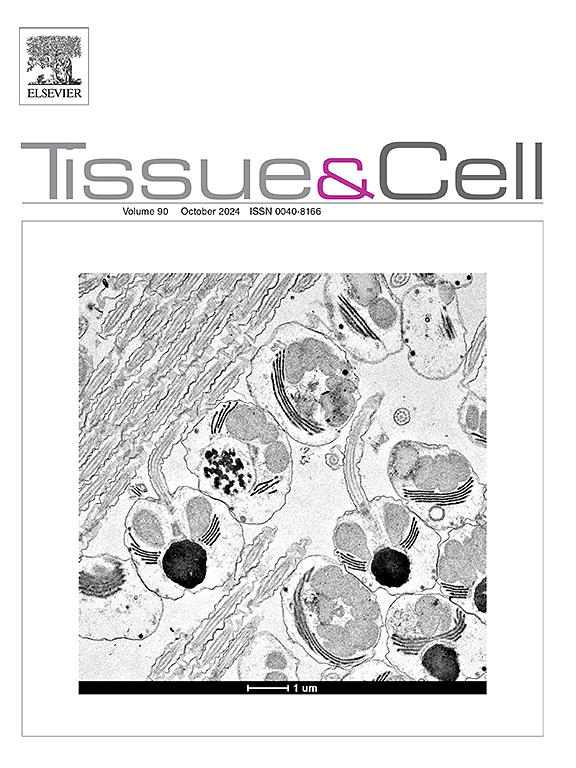Anterior cruciate ligament reconstruction affects the development of muscle atrophy depending on its timing in rats
IF 2.7
4区 生物学
Q1 ANATOMY & MORPHOLOGY
引用次数: 0
Abstract
After anterior cruciate ligament (ACL) reconstruction, muscle atrophy is frequently observed. No conclusions have been reached on the effects of timing of surgery on muscle atrophy. We aimed to determine the best timing of ACL reconstruction surgery to minimize muscle atrophy. Eight-week-old male Wistar rats were used. After 1, 14, or 28 days of ACL transection, rats underwent ligament reconstruction. Some ACL-transected rats were reared without ligament reconstruction. Untreated rats served as controls. At 56 days after ACL transection, muscle atrophy in the rectus femoris and gastrocnemius were assessed. There were no significant differences in any of the parameters relevant to muscle atrophy between the control and ACL-transected rats. ACL reconstruction did not significantly change the parameters relevant to muscle atrophy in the rectus femoris, regardless of timing. In the gastrocnemius, ACL reconstruction resulted in a reduction in slow fiber cross-sectional area (CSA) and an increase in the proportion of fast fiber in the deep region, but not in the superficial region, regardless of timing. When reconstruction was performed at 28 days, a reduction in fast fiber CSA in the deep region was also detected. In conclusion, ACL reconstruction did not alter atrophic parameters in the rectus femoris, while it caused slow fiber atrophy and an increase in the proportion of fast fiber in the deep region of the gastrocnemius, regardless of timing. However, delayed reconstruction surgery developed fast fiber atrophy as well in the deep region of the gastrocnemius. Thus, reconstruction surgery should be performed as soon as possible.
前交叉韧带重建对大鼠肌肉萎缩的影响取决于其发生的时间
前交叉韧带(ACL)重建后,经常观察到肌肉萎缩。手术时间对肌肉萎缩的影响尚未得出结论。我们的目的是确定前交叉韧带重建手术的最佳时机,以尽量减少肌肉萎缩。使用8周大的雄性Wistar大鼠。大鼠在ACL横断1、14或28天后进行韧带重建。一些acl横断的大鼠不进行韧带重建。未治疗的大鼠作为对照。在前交叉韧带横断56天后,评估股直肌和腓肠肌的肌肉萎缩。在对照组和acl横断的大鼠之间,与肌肉萎缩有关的任何参数均无显著差异。无论何时,前交叉韧带重建均未显著改变股直肌肌萎缩相关参数。在腓肠肌,前交叉韧带重建导致慢纤维横截面积(CSA)的减少和深区快纤维比例的增加,但在浅表区没有,与时间无关。当在28天进行重建时,也检测到深区快速纤维CSA的减少。综上所述,前交叉韧带重建不改变股直肌的萎缩参数,而引起腓肠肌深部纤维缓慢萎缩和快纤维比例增加,与时间无关。然而,延迟重建手术在腓肠肌深部也出现快速纤维萎缩。因此,应尽快进行重建手术。
本文章由计算机程序翻译,如有差异,请以英文原文为准。
求助全文
约1分钟内获得全文
求助全文
来源期刊

Tissue & cell
医学-解剖学与形态学
CiteScore
3.90
自引率
0.00%
发文量
234
期刊介绍:
Tissue and Cell is devoted to original research on the organization of cells, subcellular and extracellular components at all levels, including the grouping and interrelations of cells in tissues and organs. The journal encourages submission of ultrastructural studies that provide novel insights into structure, function and physiology of cells and tissues, in health and disease. Bioengineering and stem cells studies focused on the description of morphological and/or histological data are also welcomed.
Studies investigating the effect of compounds and/or substances on structure of cells and tissues are generally outside the scope of this journal. For consideration, studies should contain a clear rationale on the use of (a) given substance(s), have a compelling morphological and structural focus and present novel incremental findings from previous literature.
 求助内容:
求助内容: 应助结果提醒方式:
应助结果提醒方式:


